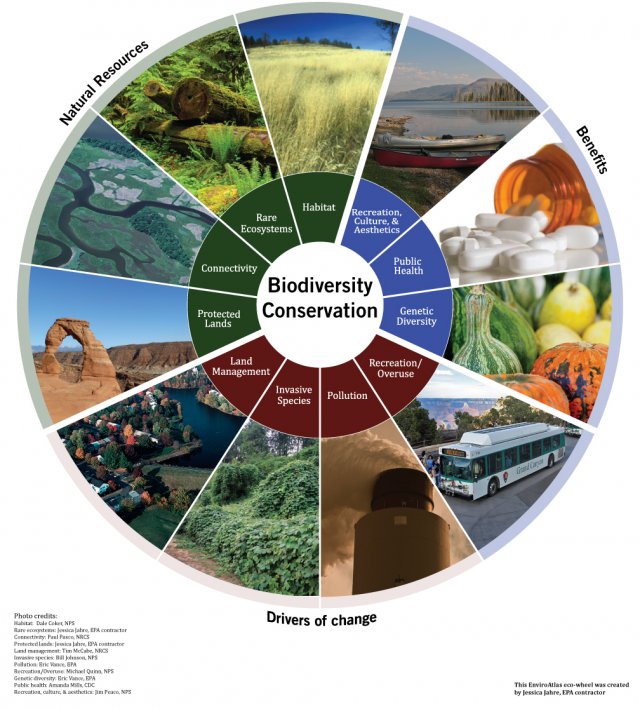EnviroAtlas Benefit Category: Biodiversity Conservation
Biodiversity underpins all ecosystems and their services
- BiodiversityRefers to the variety and variability among living organisms and the ecological complexes in which they occur. Diversity can be defined as the number of different items and their relative frequencies. For biological diversity, these items are organized at many levels, ranging from complete ecosystems to the biochemical structures that are the molecular basis of heredity. Thus, the term encompasses different ecosystem, species, and genes. is the variety of all forms of life and it is essential to the existence and proper functioning of all ecosystemsAll living things and nonliving things in an area, as well as the interactions between them..
- Biodiversity supports habitats for all species by providing many unique environments in which species can exist; these include ecosystems of all types and sizes, rare ecosystems, and corridors between habitats.
- Many scientists believe biodiversity, as it represents all forms of life on earth, provides or supports the core benefits that humans derive from their environment.
- Biodiversity is fundamental for the provision of ecosystem services, which we depend on for food, air, and water security, and multiple other natural benefits.
Stressors and drivers of change
Many human activities can have a negative effect on biodiversity.

This eco-wheel image shows natural resources provided by biodiversity, the benefits and beneficiaries, and drivers of change. - The growing human population and the land development that comes with population growth can be especially detrimental because land conversion and subsequent loss of habitats can affect the stability or continued existence of species.
- Habitat loss is a challenge for virtually all species, as humans convert natural habitats to other land uses.
- Overexploitation from extractive uses, such as commercial fishing and game hunting, can greatly reduce species numbers, sometimes to the brink of extinction1.
- An extreme decline was observed in U.S. stocks of Atlantic cod following overexploitation and stock depletion.
- The Food and Agriculture Organization (FAO) estimates that in 2008, approximately 32% of fish stocks were overexploited, depleted, or recovering from depletion2.
- Upsetting the viability of a single species can have far-reaching impacts for the balance of an entire ecosystem.
- People can also harm biodiversity by putting stress on environments and species through overuse. Outdoor recreation may be a positive, healthful activity for humans, but high numbers of visitors to an area can damage plant life, stress local animal populations, and introduce invasive speciesA type of plant, animal, or other organism that does not naturally live in a certain area but has been introduced there, often by people. An invasive species can spread quickly, especially if it has no natural predators in its new home. An invasive species can hurt native species, disrupt ecosystems, and create problems for people (for example, weeds and insects that damage crops)..
- Invasive species can outcompete or consume native species to the point of extinction. Some invasive species that are found in the U.S., such as kudzu and the Emerald Ash Borer Beetle, can completely alter ecosystems, affecting overall biodiversity.
- All forms of pollution, from chemicals to nutrient loading, can also pose serious threats to aquatic and terrestrial species.
The benefits of conserving biodiversity
- Biodiversity supports food security and sustained livelihoods through overall genetic diversity.
- Genes regulate all biological processes on the planet and increase the ability of organisms to cope with environmental stressors.
- Preserving genetic diversity ensures the continuing existence of a wide-range of crops that may be able to withstand disease, and potentially useful biochemicals such as those used in healthcare. It also means availability of species for pollination and pest control. Losses in genetic diversity will decrease organisms' coping ability and risk losing potentially beneficial biological information3.
- Biodiversity has greatly contributed to modern medicine and advancements in human health research and treatment.
- Many modern pharmaceuticals are derived from plant species, including the anti-tumor agent Taxol from the Pacific yew tree, the anti-malarial artemisinin from sweet wormwood, and the cardiac drug digoxin from the digitalis plant.
- Pharmaceuticals can also be derived from non-plant species, such as the drug ziconotide, which has been highly effective in relieving nerve pain and severe pain in cancer patients and is derived from the venom of predatory cone snails4.
- Without the species that provide these drugs, it is possible that treatments for ailments like malaria, tuberculosis, cancerous tumors, congestive heart failure and multiple other illnesses may never have been discovered.
- As conversion of habitats and subsequent losses in diversity take place, the potential for losing cures for some of the world's most troubling ailments increases.
- In addition to the many medicinal benefits from biodiversity, human health can be positively affected simply by spending time in outdoor environments, which has been linked to increases in life satisfaction and happiness, and decreases in blood pressure, anxiety, and cardiovascular disease symptoms.
- Conserving biodiversity and protecting a wide range of habitats maintains the many benefits that this diversity provides for all species. Highly diverse environments, such as Yellowstone National Park, are prime ecosystems that support many species in addition to being aesthetically beautiful, educational, and interesting recreation sites.
- Biodiversity conservation efforts are essential in maintaining functioning ecosystems, a steady food supply, and the multiple other benefits including aesthetics, recreation, and spiritual purposes to Native American tribal nations5.
References
- Rosser Alison and Mainka, SA. 2002. Overexploitation and Species Extinctions. Conservation Biology, vol 16 (3), p 584 - 6.
- FAO. 2010. The State of World Fisheries and Aquaculture: 2010 Accessed March 2013.
- Groom M J, Meffe G K, & Carroll, C R. 2006. Principles of Conservation Biology, 3rd ed. Sunderland, Massachusetts, USA: Sinauer Associates.
- Co-operation on Health and Biodiversity. 2010. Biodiversity and Human Health Policy Brief. Accessed March 2013.
- United Nations Environment Program. 2005. Millennium Ecosystem Assessment. Ecosystems and Human Well-being: Current State and Trends. CH 4: Biodiversity. Accessed March 2013.
